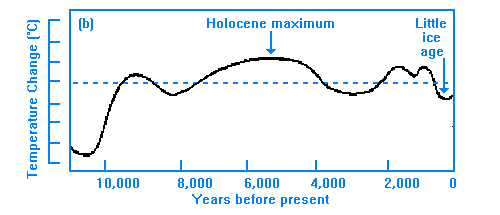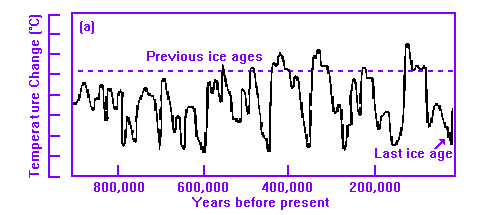



1. Evidence of Little Ice Age
Modern Scientific data
2. Volcanic Activity:
- During the Little Ice Age, records show that this was a period
of numerous volcanic eruptions.
- As volcanoes erupt they spit particles and gases into the air,
an event leading to the aerosol effect.
- Aerosol effect reduces the amount of incoming solar heat by
relecting it back into space. This increases the earth's albedo. A higher
albedo coincides with lower temperatures-a cooling if you will.
- An example of this idea can be seen in the eruption of Tambora.
This eruption produced so much gases and particles that it lowered earth's
temperature enough that it robbed Europe of a summer the following year
(The year without a summer).
3. Surface Albedo:
-Continued low temperatures, for whatever reason, produced snow
and ice.
- More snow and ice equals more reflective surfaces to deny sun's
radiant energy from reaching teh earth's surface leading to additional
cooling. Again staging a situation for the formation of more snow and ice.
- A positive feedback mechanism.
4. Milankovitch Theory:
- Eccentricity. The degree of roundness of the earth's spherical
shape.
- Tilt. Stronger tilt leads to a more varied seasonal climate.
- Precession of Equinox. Position of the earth on its elliptical
path around the sun.
- During the Little Ice Age (LIA), all these factors were thought
to have been situated in a fashion that allowed for such a prolonged period
of cooling.
- This theory is met with scepticism in that some of the cycles
mentioned (eccentricity, tilt and precession of equinox) require more time
than what was allowed by the LIA period.
5. Ocean-Atmosphere Conveyor System:
-Occurs only in the N. Atlantic ocean-atmosphere domain.
- Warm tropical Gulf Stream ocean currnts and winds are conveyed
up to the north to meet cold Arctic waters and air.
- Within this area you have atmospheric lows and highs:
atm. lo: Forces air away from air mass center due to correolis effect.
Outward tending winds will force ocean currents to diverge from the center
as well.
atm. hi: Opposite of atmospheric lo.
- It is these divergent tendencies of the N. Atlantic that keeps
the Gulf Stream powered. If an atm. hi replaced an atm. lo currents would
converge, thus weakening the Gulf Stream which was thought to possibly
have occured during the LIA.
- Lack of warm winds and currents reaching the north would not
warm the cold climate of the north possibly producing snow and ice.
- This idea holds very sceptical because this event was localized,
whereas the LIA was a global scale event.